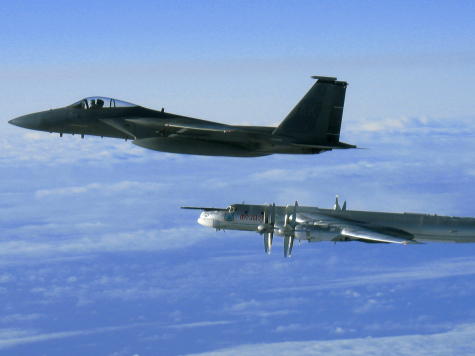
The Dutch Defense Department said it scrambled two F-16s from Volkel air force base to intercept a pair of Russian TU-95 Bear strategic bombers approaching their airspace from the North Sea.
The Russian provocation comes just a week after Defense Minister Jeanine Hennis acknowledged the Dutch were considering sending warplanes to assist NATO in the Baltic or the Black Sea regions. With tensions running high in Eastern Europe, NATO air forces are stretched due to stepped-up patrols in the Baltic States.
It appears that President Vladimir Putin just reminded the Dutch that if they want to interfere with the Russian affairs by supplying warplanes to NATO in Eastern Europe, the Russians have the military capability to visit the Dutch at home.
The Tupolev Tu-95 (Bear Bomber) is essentially a copy of the American Boeing B-29 Superfortress that flew in WWII, and it became the Soviet Union’s first intercontinental bomber in 1956. Because of its distinctively swept-back wings and four turbo-fan engines that each drive two contra-rotating propellers, it is one of the noisiest military aircraft on the planet. By sending the nuclear-capable bombers into Dutch airspace, the Russians must have wanted their intrusion to be visible on every NATO radar site in the region to generate the greatest possible amount of Dutch and European media awareness.
As I reported earlier this month, NATO Secretary-General Anders Rasmussen admitted, “We in Europe have disarmed too much, for too long.” To step up patrolling of the Baltic States borders with Russia, NATO will have to rely on a group of aging and wildly diverse aircraft. That grab-bag of manufacturers includes the American F-16AM, F-16C, F-16CJ, F-15C and F-4F; the British Tornado F3; the Russian MiG-29A and MiG-21C; the French Mirage F1M, Mirage F1CR and Mirage 2000C; the Swedish JAS-39C; and the Eurofighter Typhoon. Most NATO planes lack modern avionics and can only exercise limited command integration. The MiGs operated by NATO Eastern European members require Russian parts and support to maintain combat readiness.
It is expected that within a few months air cover will deteriorate unless other NATO members, such as the Dutch, provide needed warplanes. The Dutch operate 61 F-16s and two Lockheed Martin F-35s, which are both highly competitive combat aircraft. When Ms. Hennis was questioned on the Dutch Defense Department’s willingness to respond to NATO’s urgent call for combat aircraft to confront Russia, she said, “We are members of an alliance for a reason, and we will take our responsibilities.” Asked specifically what form Dutch air support could take, the minister said, “It could mean sending an F-16.”
The Dutch last responded to a NATO urgent call in 2006 for assistance in Afghanistan. However, after 24 Dutch troops died during the four-year mission and 140 were wounded, the Dutch withdrew their four F-16s and 2,000 soldiers on August 1, 2014. The departure came at the height of the Obama administration’s Afghanistan surge and was seen as a major diplomatic and military undermining of President Obama’s leadership.
The Dutch defense ministry statement said incidents such as the Russian bombers’ flyover have occurred before, citing one from March 21 and another from Sept. 10 last year. Anders Fridberg, spokesman for the Danish Defense Command, said the Russian planes came in from the north: “We just followed them and just turned back when we reached Germany.” There have been no further comments regarding the Dutch willingness to assist NATO.
The author welcomes feedback and will respond to comments by readers.

COMMENTS
Please let us know if you're having issues with commenting.